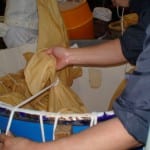It is a rare occasion and ceremony that does not include some sake in Japan, and that harbinger of renewal, New Year’s Day, is no exception. Although sake figures prominently in O-shogatsu (New Year’s) celebrations from morning to night, opening the year with a prayer for health in the form of drinking O-toso is perhaps the most interesting.
Just what is O-toso? It’s sake that has been specially prepared by steeping a mixture of  herbs in it for several hours. Drinking it with family in ceremonial fashion first thing on New Year’s day is said to ward off sickness for the entire year ahead, as well as invite peace within the household.The tradition of O-toso originally came from China, and originally the mixture consisted of eight herbs. Things have naturally changed slightly over the years, and some of the herbs have changed as a couple in the original concoction were deemed too potent. But most remain true to the original recipe.
herbs in it for several hours. Drinking it with family in ceremonial fashion first thing on New Year’s day is said to ward off sickness for the entire year ahead, as well as invite peace within the household.The tradition of O-toso originally came from China, and originally the mixture consisted of eight herbs. Things have naturally changed slightly over the years, and some of the herbs have changed as a couple in the original concoction were deemed too potent. But most remain true to the original recipe.
Included in the mixture are cinnamon, rhubarb and sanshou (Japanese pepper), as well as a few not commonly seen in the west, like okera (atractylodis rhizome) and kikyou (platycodi radix). It’s stuff you never knew you needed, much less existed.
O-toso was adopted in Japan back in the ninth century during the reign of the Saga Emperor in the Heian era. Back then, on December 19 of each year the herbs were placed in a triangular bag and hung from the branch of a peach tree hanging over water. At four in the morning on New Year’s Day, the herbs were put into sake and steeped for several hours before being partaken of in the morning.
During the Edo era (1603-1868), the custom became common among common folk as pharmacies would give out the O-toso mixture (known as O-tososan) to patients as year-end gifts. This practice continued to some degree until about 20 years ago.
The custom has evolved into a fairly ritualized form over the years. After morning greetings on O-shogatsu, the O-toso is drunk using a special set of three lacquered vermillion cups sitting on a small dais. The three cups fit inside each other, and are drunk from in order of size: small, medium then large. It is poured not from a normal sake tokkuri, but from a special vessel resembling a kyusu (teapot).
The O-toso is drunk in order from the youngest in the family to the oldest with the intention that the older members of the family can share in the joy of youth imparted as the cups are passed.
Drinking O-toso is said to ward off infectious diseases like colds for the year. Folklore dictates that if just one member of the family drinks O-toso, everyone in the family will be free from illness. If the entire family drinks it, the whole village will remain free from illness for the year.
Making it at home is easy, provided you know where to go and pick your wild bekkatsu (smilax China), bofu (ledebouriellae radix) and uzu (aconite root). Combine those with the five mentioned above and you’re golden.
A simpler solution if you happen to be in Japan, or near a Japanese food store outside of Japan, is to go and pay just a wee bit indeed for an elaborately packaged teabag of O-tososan. On New Year’s eve, stick that puppy in about 300 ml of sake and let it steep for seven or eight hours. It will be ready first thing in the morning.
It is also possible to use mirin (a kind of cooking sake), which has less alcohol, or a mixture of mirin and sake. While this may make it taste a bit sweeter, the taste of O-toso made with good sake is not bad at all. A bit medicinal and slighter bitter, perhaps, but interesting.
Also, should guests visit during the first three days of the new year, they are first given a glass of O-toso, and after that a glass of sake.
As is the fate for many traditional rituals, the O-toso ceremony is not as commonly practiced these days as it has been in the past. Many younger people, in fact, may not know all that much about it. Although all things run their natural course, it would be a pity if O-toso were to totally fade away.
Those not in Japan should be able to find the O-toso teabags at drugstores or grocery stores in Japanese neighborhoods.
Another common type of sake enjoyed at New Year’s time is taru-zake. Like O-toso, taru-
zake is not a brand of sake, and almost all brewers make some. Taru-zake is made by taking regular sake and letting it sit in a taru, or wooden cask for (usually) a couple of days. It then takes on a fairly strong and pleasant cedar taste and aroma. While this usually overpowers any subtler flavors and aromas (which is why premium sake is rarely used for taru-zake), it can be very enjoyable and tasty.
Just after New Year’s Day, when people gather for traditional year-opening ceremonies in communities, families and companies, taru-zake is often the sake of choice. Very often, taru-zake is enjoyed from the small wooden boxes called masu, and with a pinch of salt in one corner.
For those outside of Japan, both taru-zake and masu are available if you poke around. At least in North America, one recommended brand of taru-zake is Ichi no Kura from Miyagi, although at least one domestic brewer makes some as well.
Be it O-toso, Taru-zake, or something else, all the best to everyone in 2016!
***************************************************************************************
Three holiday sake gift ideas:

(1) A subscription to the magazine Sake Today http://ow.ly/VOYWi
(2) the book Sake Confidential http://ow.ly/VOZ24
(3) the 99-cent app The Sake Dictionary http://ow.ly/VOZ6c
The only question is, how much do you – or that special someone – want to read?





 In the movie (and play), “A Bronx Tale,” the members of a particular fraternal organization centered around their ethnicity ran a bar into which a group of members of another fraternal organization, this one centered on their preference for two-wheeled vehicles, attempted to enter.
In the movie (and play), “A Bronx Tale,” the members of a particular fraternal organization centered around their ethnicity ran a bar into which a group of members of another fraternal organization, this one centered on their preference for two-wheeled vehicles, attempted to enter. shaking and shooting their beer and creating every kind of ruckus imaginable. At which point the head wise guy shuts the door ominously, looks around the room, and says, “Now youse can’t leave.”
shaking and shooting their beer and creating every kind of ruckus imaginable. At which point the head wise guy shuts the door ominously, looks around the room, and says, “Now youse can’t leave.” Of course, all this naturally leads to questions relating to how young is still young enough, or conversely stated, how old is too old? In actuality, there is no simple answer, which is why following the “younger is better, don’t mess around with aging sake at home” philosophy is best at first. But the ultimate truth is a bit higher than that.
Of course, all this naturally leads to questions relating to how young is still young enough, or conversely stated, how old is too old? In actuality, there is no simple answer, which is why following the “younger is better, don’t mess around with aging sake at home” philosophy is best at first. But the ultimate truth is a bit higher than that.